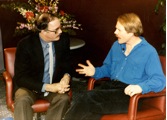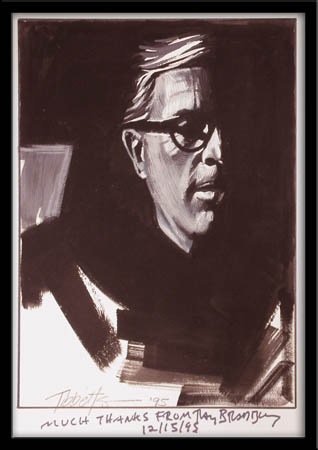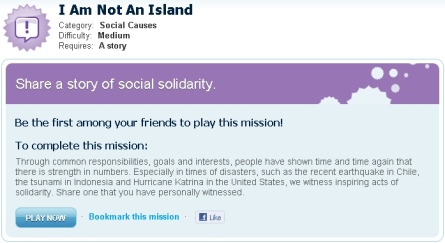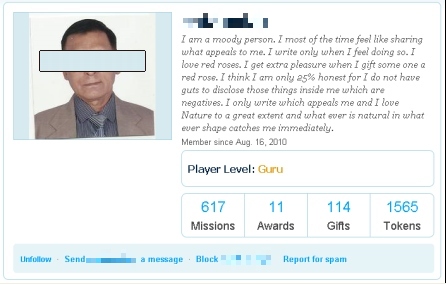Over the Rainbow: John C. Tibbetts Opens Archive of Interviews
/Over the past year or so, I've been enjoying an active correspondence with John C. Tibbetts, a long-standing film researcher, who recently put out a three volume collection of highlights from American Classic Screen, a publication which in its day represented an important bridge between the world of film buffs and cineastes, on the one hand, and film scholars on the other. For a period of time, academic film scholars seemed eager to burn some of these bridges, gaining academic respectability at the expense of cutting themselves off from fans and journalists who shared their passions for film. Tibbetts is one of the film scholars who has kept these bridges very much in tact, working through the years as a practicing journalist, as well as teaching at the University of Kansas. He's recently opened a remarkable website which showcases several decades worth of interviews with some of the top creative talents of the era, one which as he explains below is fearless in bridging high and low and cutting across a range of different media. Whatever your interests, there is sure to be material here which will be invaluable to you. "OVER THE RAINBOW": A STATEMENT BY JOHN C. TIBBETTS, UNIVERSITY OF KANSAS

I want to thank Henry Jenkins for this opportunity to welcome you to my new website, "Over the Rainbow," administered through the University of Kansas. It contains hundreds of my video and audio interviews spanning 35 years with pop and classical figures in the arts and humanities. The address is: kuscholarworks.ku.edu/dspace/handle/1808/6581. Now in progress, and accessible to scholars, fans, and enthusiasts, "Over the Rainbow" has grown to more than sixty video interviews and soon will include hundreds more video and audio interviews. Eventually, they will be accompanied by brief annotations and illustrations to alert the viewer/reader to their contents.
How did I gain access to these interviews (I prefer to call them "conversations")? Opportunities for contacts were numerous. Before gaining my tenure as an associate professor in Film and Media Studies at the University of Kansas in 1998, I worked as a full-time radio and television broadcaster and free-lance journalist for CBS television, the Christian Science Monitor radio network and newspaper, Voice of America, National Public Radio, and several classical music radio stations. At the same time I edited the National Film Society's house magazine, American Classic Screen.

A NOTE ABOUT THE INTERVIEWS
These conversations encompass the worlds of "classical" and "pop" culture, with artists and performers "high" and "low," from the scholar's studio to "drive-by" encounters on the road--at backstage rehearsals, in private homes, movie premieres, music festivals, academic conferences, science fiction/horror cons, etc. As you will see, it could be argued that I have shown little discrimination in these subjects, be they "high" and "low," or somewhere in between. So be it. That's the world we live in; the media borders are porous. As Henry Jenkins has declared, "Today we are trying. . . to build bridges, to open larger conversations, and to join forces with fans and industry alike as we explore the new directions being taken within media culture."
Thus--to cite a few examples of these "bridges,"--you will find here conversations about music with blues man "Screamin'" Jay Hawkins" in a Kansas City bar and with opera star Luciano Pavarotti in the back of a luxury limousine. There are talks about gothic horror with popular novelists Stephen King and Robert (Psycho) Bloch; and with academics Professors Richard (The Age of Wonder) Holmes and Harold Schechter (The Bosom Serpent). Composer Jerry Goldsmith talks about composing for Star Trek, and "classical composer" Virgil Thomson remembers composing for Orson Welles and Robert Flaherty. Jazz pianist Ahmad Jamal and classical violinist Nigel Kennedy demonstrate techniques of improvisation. Comic book artist Bob Kane talks about creating Batman, and award-winning children's book illustrator Chris Van Allsburg remembers writing The Polar Express and Jumanji. Movie soundtrack composer Ry Cooder and Professor Charles Hamm trace American blues traditions to 19th-century African-American roots. Hollywood mainstream directors James Cameron and Tim Burton talk about Aliens and Batman, and international filmmakers Bernardo Bertolucci and Peter Weir discuss their work in the Italian and Australian "New Waves."
While on the road, like a modern-day flaneur, I've always kept my microphones and cameras at the ready. I found Ray Bradbury at Disney's WED studios while working on EPCOT's "Spaceship Earth"; Robert Altman at Kansas City's fabled 18th and Vine locations while shooting Kansas City; concert pianist Vladimir Ashkenazy backstage at a Duesseldorf concert hall after a recital; historian Kevin Brownlow in the basement of his London Photoplay offices while finishing his documentary, The Tramp and the Dictator; Chevy Chase at a barbecue on the rim of the Grand Canyon after finishing National Lampoon Vacation; Jeremy Brett backstage in a West End theater before a performance of The Mystery of Sherlock Holmes; Arthur Conan Doyle's daughter, Dame Jean Bromet, in her London flat dispensing tea and cakes while recalling her father's forays into Spiritualism. George Burns in a Las Vegas casino while talking about Oh, God!; and slugger Bo Jackson in the Kansas City Royals dugout before a ballgame.
Inevitably, there are those deliciously unexpected incidents that flavor many of these conversations. Tape recorder in hand, I follow Maurice Sendak backstage while he paints scenery for a performance of the opera version of Where the Wild Things Are. I accompany Christopher Reeve and Margot Kidder to the Smithsonian Institute, where they gaze in rapt amazement at the installation of the "Fiftieth Anniversary of Superman" display. Venerable concert pianist Charles Rosen interrupts our talk with a sudden discourse on Hollywood "B" movies. I clamber aboard the Memphis Belle B-17 bomber (now housed at Mud Island, near Memphis) with members of the original crew during on-site conversations about their participation in William Wyler's titular 1943 documentary classic. I watch while Douglas Fairbanks, Jr. illustrates his swashbuckling memories of working with Max Ophuls on The Exile by brandishing a sword he kept in his apartment's umbrella stand. I listened while an ageing Adriana Casellotti (the voice of Disney's Snow White) punctuates her memories of the film with shrill reprises of "Someday My Prince Will Come." While talking about Back to the Beach, Annette Funicello and Frankie Avalon suddenly launch into their "Beach Party" theme song. A stark naked Tony Bennett changes costumes during a photo shoot in Los Angeles. Kermit the Frog likewise appears nude (courtesy of Jim Henson's open hand) when he interrupts Henson's remarks about Sesame Street. Instead of closing our conversation about The Color Purple with the traditional handshake, Steven Spielberg extends his hands for a quick game "patty-cake. Look closely, and you'll see Debra Winger punctuating her remarks by munching on a potted plant. Brian Dennehy responds to my invitation to offer career advice to his young co-star, Tyrone Power, Jr., in Cocoon 2 with these immortal words: "Use a little less lip gloss, kid!" Avant-garde composer John Cage finds sudden inspiration for a discourse on "found music" when an ice cream truck tinkles out its melodies below our window. And my tape recorder is rolling while Clarence "Ducky" Nash (the voice of Donald Duck) breaks up a restaurant crowd with one of Donald's squawking tantrums.
The old adage that the bigger they are the nicer they are certainly holds true in my experience. Tops on my list of Good Guys are directors Ron Howard and Richard Donner; actors Michael Caine, Meryl Streep, Morgan Freeman, Danny DeVito, Michael Douglas, Sigourney Weaver, Jeff Bridges, and DeForest Kelly ("Bones" on Star Trek); academics Jacques Barzun and Susan Sontag; and ragtime composer Max Morath and opera composer William Bolcom. In particular, I'll never forget my many interviews with Arnold Schwarzenegger. Long ago, during his Conan the Barbarian days, Arnold's consummate professionalism and his love of publicity already marked him as a born politician. The losers. . . well, discretion bids me hold my tongue, but can you spell T-0-M-M-Y L-E-E J-O-N-E-S?
A NOTE ON MY AUTOGRAPHED PORTRAITS

Soon to accompany the interviews on the "Over the Rainbow" web site are hundreds of my sketches and paintings of the interview subjects. This hobby--or whatever it is--began long ago in 1966 when author Ray Bradbury inscribed my portrait of him with greetings from the characters in his stories. Not only did that launch a friendship I cherish to this day (Ray is in his late 80s now), but I was inspired to capture more likenesses and inscriptions. They now number more than 300 images.

My portraits have had their advantages during my interviews. Sometimes they triggered unexpected conversations with the subjects. Gene Hackman showed me some of the sketches he makes between takes on the movie set, and Julie Andrews and Whoopi Goldberg confessed what they really want to do is write children's books. Maybe strangest of all, Broadway superstar Mary Martin told me that she paints portraits too! But not the conventional views of faces; no, she's talking about drawing the backs of their heads. "You see," she explained, "when I was on stage during the run of The Sound of Music, I got to know the Von Trapp kids by the backs of their heads during the "do-re-mi" song. So I gave them each a drawing of the backs of their heads. And since then, I've given all my friends portraits of the backs of their heads. It's become my trademark! I also blush to admit that in swaps for my art work, fantasy illustrator Joseph Mugnaini doodled fantastic designs on my Hollywood hotel stationery, Bob ("Batman") Kane tossed off a drawing of the Dynamic Duo in the bar of the Sheraton-Universal Hotel, and Chuck Jones dashed off a Daffy Duck/ "Scarlet Pumpernickle" drawing in his Hollywood office.
I welcome all of you to visit my web site at the University of Kansas. You may find a few insights and provocations amidst some of the laughs and tom-foolery.
John C. Tibbetts (tibbetts@ku.edu)

John C. Tibbetts is an Associate Professor in the Department of Theatre and Film at the University of Kansas, where he teaches courses in film history, media studies, and theory and aesthetics. His most recent books are Composers in the Movies: Studies in Musical Biography (2005, Yale University Press), Schumann: A Chorus of Voices (2010, Amadeus Press), and the three-volume American Classic Screen (Scarecrow Press, 2010). Forthcoming is Voices of Wonder: Conversations on Classic Fantasy, Science Fiction, and Horror.




























